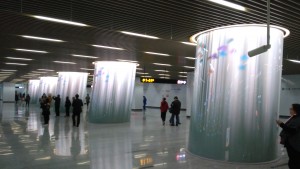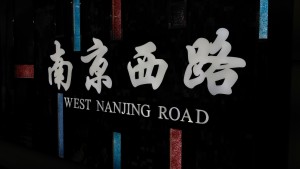Shanghai Street View: Stylish Subways

Everyone has been buzzing this past week about the new additions to Shanghai’s subway system, which has become one of the world’s biggest since its explosive expansion starting around the World Expo of 2010. But while the earlier focus was on simply opening new lines and stops at a breakneck pace, now the city is turning its attention to the more subtle art of trying to make these newest stations more artistic and individual by incorporating themes related to China and Shanghai itself.
The attempt to make our subway more attractive is part of a broader trend that has seen many Chinese cities move beyond an earlier mentality that focused solely on functionality, to one where they try to create spaces, buildings and other elements that add some local flavor. In Shanghai’s case such a move is quite easy, since the city has such a rich history and also boasts many buildings and other historical sites and relics that are still present and in relatively good condition.
Most of the new subway stops to open were on extensions of lines 12 and 13, finally giving Shanghai a comprehensive underground transport system throughout the old city area. The addition of all the new routes means Shanghai now has a total of 617 kilometers of underground track, quite an impressive feat for a city that didn’t even start building its network until the 1990s.
Much of the buzz around many of the newest stations has centered on the attempts to give them their individual personalities with individual themes and motifs. Such themes aren’t completely new, though in the past there weren’t too many examples. One of the few was the Hailun Road station on Lines 10 and 4 near my home in Hongkou, which has several murals describing the life and work of 20th century novelist and prominent thinker Lu Xun, whose historic home is nearby.
All the media fuss over the new focus on artistry piqued my curiosity, prompting me to visit some of the new stations that have become the biggest focuses of attention. I’ll admit I wasn’t overwhelmed by what I saw, though the themed stations were certainly more interesting than the many existing ones that don’t have any individual character at all.
My journey began at the new West Nanjing Road station, which is actually 3 separate stations for lines 12, 13 and the original line 2. Apparently linking up all the stations was too big an engineering feat due to the area’s high degree of development, leading to this somewhat uniquely Shanghai phenomenon of forcing people to come out of one station and walk briefly along the street to make a transfer.
Modern Classical Look

One of the new West Nanjing Road stations on line 12 had a theme inspired by a modern interpretation of classical Chinese architecture, something akin to the old China Pavilion at the World Expo that has now become our city’s primary art museum. The line 13 station was less distinctive, featuring brightly colored glass panels that gave it a modern feeling.
I was quite disappointed to find the nearby stop outside our new Natural History Museum didn’t really have much of a theme at all, especially since it would have been quite easy to fill the station with dinosaurs and other ancient animals as motifs. One of the biggest hits among city residents was the new Hanzhong Lu station, which has become a major interchange between lines 1, 12 and 13. That station featured a fish motif, including a mural with glowing fish and several massive glass columns with 3D images of glowing fish inside that were attracting big crowds.
The relative pageantry in the new stations contrasts sharply with my earliest memories of subways in China. For years Beijing had a monopoly on subways in the country, and one of my sharpest memories of China in the 1980s was riding the rickety system in the nation’s capital. That system was about as utilitarian as they come, without much consideration for aesthetics or even practicality. The whole system had only two lines, and changing from one to the other required walking outside for about a kilometer and paying 2 separate fares.
Even Shanghai’s original lines 1 and 2, both opened in the 1990s, seem a bit anachronistic in the state-of-the-art subway system we see today, and artistry and individuality were probably quite low on the priority lists in their design at the time. Fast forward to today, when I have to at least applaud Shanghai for trying to add some personality to the stations, even if the results are a bit mixed. That kind of effort is ultimately what will give Chinese cities like Shanghai their own special personalities, and extend the recent trend of moving beyond simple functionality to creating urban landscapes that are truly unique.
